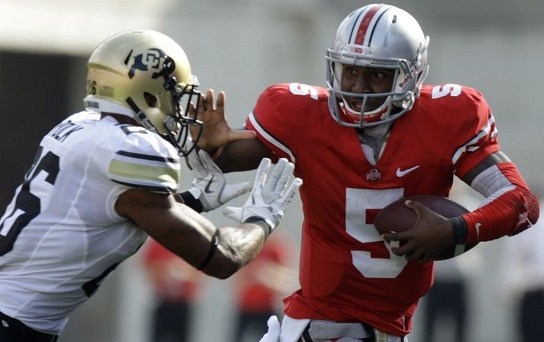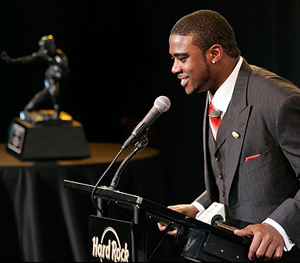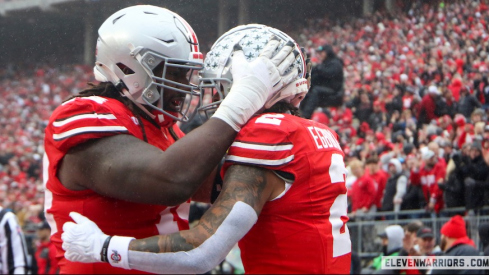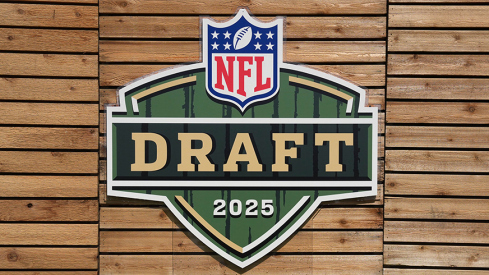 Pose looks good on ya kid.
Pose looks good on ya kid.Last week I computed “championship defense benchmarks”, compiled by taking the averages of key stats from the past five national champion defenses. I then compared those figures to OSU’s defensive performance in 2011 in an effort to discern just how far (and in some cases how close) the Silver Bullets are from championship caliber.
Well, last week was so much fun that I decided to try the same exercise (hold your applause until the end please)! Only this time I wanted to zero-in on a single position instead of an entire side of the ball.
This week I took a look at the past five Heisman Trophy winning QBs, and compared their stats to Braxton Miller’s from his Freshman year campaign. The conclusion: he’s got nowhere to go but up.
Methodology
In an effort to compile “Heisman Trophy Winner Benchmarks”, I took a look at the Heisman campaigns of the last five QB’s to win college football’s most coveted individual award (Robert Griffin III (’11), Cam Newton (’10), Sam Bradford (’08), Tim Tebow (’07) and our very own Troy James Smith (’06)). Stats analyzed included passing attempts, completions, completion %, total passing yards, passing yards per attempt, TDs, INTs, rushing attempts, total rushing yards, rushing yards per attempt, and rushing TDs.
Totals for the five QBs were summed and averaged to produce the Heisman Trophy Winner Benchmarks.
The benchmarks were then compared to the same statistics from Miller’s ’11 season to hypothetically determine how much farther young Braxton must climb in order to hoist Mr. Stiff Arm in December.
DISCLAIMER. I fully realize including figures like Sam Bradford’s 2008 rushing yards (47) skew the overall rushing yards average. However, there are forces pulling said average in the other direction, like Cam Newton’s freakish 1,473 rush yards in 2010. This works both ways, as Bradford’s ridiculous 50 passing TDs in ’08 bolster Newton’s much softer total of 30.
At the end of the day, I guess that’s why they call it an average. Amirite?
Finally, I wanted to make a quick note that Braxton Miller’s overall 2011 statistics were used despite not starting in the first two games.
 Heisman Trophy Winner Benchmarks are smart. Next Question
Heisman Trophy Winner Benchmarks are smart. Next QuestionTrends
Before comparing the benchmarks to Braxton’s stats, I wanted to call out a few common threads in the data among the past five Heisman Trophy winning QBs.
If you want to win a Heisman, here’s what you’ve got to do (in no particular order.)
1. Complete at least 65% of your passes – all 5 QBs did.
2. Throw for over 2,500 yards – Smith had the lowest total among the five at 2,542. Bradford had the most at 4,720.
3. Limit interceptions to a single digit – Keeping this number below 10 was something all five were able to do.
4. Pick up yards in bunches on pass plays – Each QB averaged over 8 yards per attempt.
Heisman Trophy Winner Benchmarks Compared to Miller’s 2011 Statistics
Without further ado I give you “THE COMPARISON”
PASSING
| ATTempts | Comp | comp % | Yds | Yds/ATT | TD | INT | |
|---|---|---|---|---|---|---|---|
| Benchmarks | 365.2 | 248.2 | 67.7 | 3,539 | 9.7 | 35.8 | 6.6 |
| Miller | 157 | 85 | 54.1 | 1,159 | 7.4 | 13 | 4 |
RUSHING
| Rush ATTempts | Rush Yds | AVG. | TD | |
|---|---|---|---|---|
| Benchmarks | 153.4 | 663.6 | 3.5 | 11.8 |
| Miller | 159 | 715 | 4.5 | 7 |
Key Findings
Braxton’s passing attempts are way down. The five Heisman Trophy winning QBs attempted over 200 more passes than Miller on average. Obviously, the lack of attempts drove down all of Braxton’s passing statistics in 2011. The old gambling adage: “you can’t win if you don’t play” comes to mind here.
While the majority of Braxton’s passing game fell far short of the Heisman Trophy Winner Benchmarks, there was a lone bright spot in the data: Braxton’s passing yards per attempt. Number five’s 7.4 yards per attempt fell just 2.3 yards short of the benchmark. While the 2.3 yard difference certainly adds up over time, the 7.4 number is surprising and encouraging considering the disjointed state of the passing game last season.
Miller’s attempts and yards per attempt should pick up next season with the implementation of Meyer’s quick strike offense. The system puts a premium on getting playmakers in space in an effort to rack up considerable YAC.
Braxton is limiting mistakes (sort of). Miller’s 4 interceptions fell 2.6 picks short of the Heisman Trophy Winner Benchmark. For a Freshman QB to start in 10 games and only throw four interceptions is as close to sterling as you’ll see, but unfortunately the number has just as much to do with Miller’s limited attempts as it does with limiting mistakes.
The implementation of a new system coupled with simply throwing it more will result in more than 4 interceptions in 2012. Miller will take his lumps, and while his INT number will rise, it will be more interesting to see how often Miller makes the right decision regardless of outcome. In the early stages of his development, going through his progressions and making the right read are just as important as making a great throw. As aforementioned, with more chances to air it out, Miller should get a chance to work on both.
Braxton's rushing game is meeting and in some cases exceeding benchmarks. This is the finding that should truly get Buckeye fans excited. Miller’s 715 rushing yards exceeded the Heisman Trophy Winner Benchmark by 50 yards. Possibly more impressive is his 4.5 yards per carry average, which was one yard higher than the benchmark. In addition, it exceeded all of the past five Heisman winner’s individual yards per carry totals except for Cam Newton’s who averaged 5.58 yards per rush.
In short, during his freshman campaign, Braxton Miller rushed for more yards per carry than Robert Griffin III (3.91), Tim Tebow (4.26) and Troy Smith (2.8) during their Heisman winning seasons. An impressive stat indeed.
Miller has the wheels needed to hoist the Heisman during his time in Columbus, but
it’s clear he has work to do in other areas. His stats in the passing game fall far short when compared with the averages of the past five Heisman Trophy winning QBs.
Luckily for Miller, he’s inherited a coach who doesn’t shy away from offensive production, so passing attempts and (hopefully) yards, completions and TDs should rise in tandem. Ultimately adding an air assault to complement a deadly scrambling ability.

